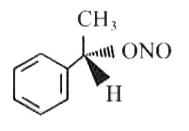Consider the following reactions
I. H3CCI3OHΘ−−→
II. H3CCHO[Ag(NH3)2]+OHΘ−−−−−−−−−−−−−→
III. H3CCO2C(2)H5OHΘ−−→
Carboxylic acid is the final product only in the reduction (s)
I,II
II,III
II
III
The correct Answer is:B
To determine which of the given reactions results in the formation of a carboxylic acid, we will analyze each reaction step by step.
Step 1: Analyze Reaction I
Reaction:
H3C-CI3OH−→
In this reaction, the hydroxide ion (OH⁻) acts as a nucleophile and attacks the carbon atom bonded to the three chlorine atoms (CCl₃). The chlorine atoms are good leaving groups, and they will be replaced by hydroxyl groups one by one.
- The reaction proceeds with the substitution of Cl atoms by OH groups.
- Eventually, the carbon will be fully substituted, resulting in the formation of a carboxylic acid salt (not the acid itself) due to the presence of OH⁻ in the basic medium.
Final Product: Carboxylic acid salt (not a carboxylic acid).
Step 2: Analyze Reaction II
Reaction:
H3C-CHO(Ag(NH3)2)+OH−→
In this reaction, we have an aldehyde (H₃C-CHO) reacting with Tollens' reagent (Ag(NH₃)₂⁺) in a basic medium.
- Aldehydes are oxidized to carboxylic acids in the presence of Tollens' reagent.
- The carbonyl group (C=O) of the aldehyde is oxidized, resulting in the formation of a carboxylic acid.
Final Product: Carboxylic acid.
Step 3: Analyze Reaction III
Reaction:
H3C-CO2C2H5OH−→
In this reaction, we have an ester (ethyl acetate) reacting with hydroxide ions.
- The reaction of an ester with a base typically leads to hydrolysis, resulting in the formation of a carboxylic acid and an alcohol.
- In this case, the ester will hydrolyze to form acetic acid (carboxylic acid) and ethanol.
Final Product: Carboxylic acid.
Conclusion
From the analysis:
- Reaction I does not yield a carboxylic acid but a carboxylic acid salt.
- Reaction II yields a carboxylic acid.
- Reaction III yields a carboxylic acid.
Thus, the reactions that result in the formation of a carboxylic acid are II and III.
Final Answer
Carboxylic acid is the final product only in the reductions of reactions II and III.
---
Reaction:
H3C-CI3OH−→
- Eventually, the carbon will be fully substituted, resulting in the formation of a carboxylic acid salt (not the acid itself) due to the presence of OH⁻ in the basic medium.
Reaction:
H3C-CHO(Ag(NH3)2)+OH−→
- The carbonyl group (C=O) of the aldehyde is oxidized, resulting in the formation of a carboxylic acid.
Reaction:
H3C-CO2C2H5OH−→
- In this case, the ester will hydrolyze to form acetic acid (carboxylic acid) and ethanol.
From the analysis:
- Reaction I does not yield a carboxylic acid but a carboxylic acid salt.
- Reaction II yields a carboxylic acid.
- Reaction III yields a carboxylic acid.
Carboxylic acid is the final product only in the reductions of reactions II and III.
Topper's Solved these Questions
- ALDEHYDES AND KETONES BOOK - ERRORLESS CHAPTER - ALDEHYDES AND KETONES EXERCISE - JEE Section Only one choice correct answer
39 Videos
- ALDEHYDES AND KETONES BOOK - ERRORLESS CHAPTER - ALDEHYDES AND KETONES EXERCISE - JEE Section More than one choice correct answer
12 Videos
- ALDEHYDES AND KETONES BOOK - ERRORLESS CHAPTER - ALDEHYDES AND KETONES EXERCISE - Ordinary Thinking (Objective Questions) Properties
207 Videos
- ALCOHOL, PHENOL AND ETHERBOOK - ERRORLESS CHAPTER - ALCOHOL, PHENOL AND ETHEREXERCISE - JEE SECTION (JEE Advanced 2018) More than one choice correct answer
1 Video
- ANALYTICAL CHEMISTRYBOOK - ERRORLESS CHAPTER - ANALYTICAL CHEMISTRYEXERCISE - JEE Section (Only One Choice Answer)
36 Videos
Similar Questions
Knowledge Check
CH3OH+C2H5OHH⊕−−→ Products
AThe product is CH3−O−C2H5.BThe product is CH3−O−CH3.CThe product is C2H5−O−C2H5.DAll KNO2−−−−−−−−→H2O,C2H5OH Product
KNO2−−−−−−−−→H2O,C2H5OH Product
The main product isA B
B C
C D
D
The reaction, (CH3)3C−IH2O−−→(CH3)3C−OH is
Aelimination reactionBsubstitution reactionCfree radical reactionDaddition reaction.
In the following reaction
CHCl3+C6H5NH2KOH−−→A+3B+3C+, the product 'A', is
View Solution2CH3CHOOH−−−→X→YH2−Pd/C−−−−−−→Z,Z is
View SolutionThe major product P in the following reaction is
(CH3)3COH+C2H5OHH+−−→P
View SolutionIn the reaction :
CH3COOH+C2H5OH→ACH3MgI−−−−→BH+−−−−−→H2OC
View SolutionName the following reaction.
C6H5−C≡NSnCl2+HCl−−−−−−−→C6H5−CH=N⊕H2]ClΘH2O−−→C6H5CHO+NH3
View Solution
